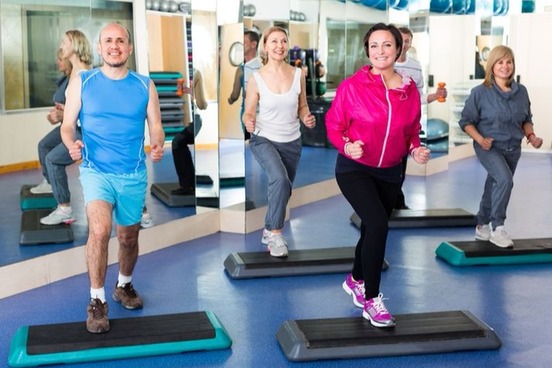
Plyometrics
Plyometrics involves increasing muscle power, especially in the legs, by the repeated rapid stretching and contracting of muscles, as by rocket-shipping vertically from a squatting position or explosively jumping over objects. The explosive jumps in plyometrics—which is sometimes called "jump training"—were made popular by the Soviet track-and-field team in the 1970s, who incorporated them in preparing for the Olympic Games. In particular, you might be familiar with the "depth jump," which is used in extreme fitness and strengthening workouts and involves repeated vertical drops from a box or bench followed by an immediate rebound back up. It was created by Soviet coach Yuri Verkhoshansky in the mid-1900s.
The name plyometrics is supposedly a combination of the Greek prefix plio-, meaning "more," and –metrics, which refers to the science of measuring and is influenced by isometrics. By all accounts, the name is a translation of a Russian word by Fred Wilt, a U.S. Olympian who became interested in the Soviet's warm-up and training exercises and introduced them to U.S. athletes and coaches. The etymology of the word isn't very useful in understanding the concept behind the exercise, but its formation may have been influenced by ply, meaning "to exert" or "to exercise," or plicate, which implies folding.

Gymnastics
Today, gymnastics refers to a sport in which individuals perform amazing acrobatic feats that demonstrate strength, balance, and body control. Traditionally, the sport encompasses calisthenics, tumbling, and floor exercises, as well as work on a variety of apparatuses, including the horizontal bars, (uneven) parallel bars, pommel horse, vaulting horse, rings, and balance beam.
The name for the sport traces back to ancient Greece. The Greeks placed a high value on both physical and mental fitness, and major cities had a public area set aside in which young men would gather to exercise, compete in sports, and receive training in philosophy, music, and literature. Living in a warm climate and not wanting to be encumbered in their activities, the Greeks would typically do their exercising in the nude. The name given to the exercise area was gymnasion, literally "school for naked exercise," ultimately deriving from the adjective gymnos, "naked." Greek gymnasion became the Latin gymnasium, which was used in two distinct senses to mean both "an exercise ground" and "a public school," and was borrowed into English at the end of the 16th century. People wear clothes in them now.

Gestation
Gestation is from Latin gestatus, which is the past participle of gestare, meaning "to bear." So its common biological sense for the carrying of young in the uterus from conception to delivery is unsurprising. However, the earliest use of gestation is for an exercise recommended for the young, ill, and frail that consisted of walking little and being carried a lot, as on a horse or in a carriage, or rowed in a boat, so as to limit sweating and exhaustion. That sense appears in the 16th century, but the theory was carried into 19th-century medicine. It's bizarre, but here's the evidence:
The two inferences of most importance to be drawn from this narrative, are, first, the extraordinary benefit derived from gestation in a carriage and still more the mixture of gestation and exercise on horseback, in arresting or mitigating the hectic paroxysm….
— Erasmus Darwin, Zoonomia, 1794As among exercises walking, so among gestations riding on horseback is far preferable to all the others; for no small portion of muscular action is required in it, but so light and so varied, that it is not only tolerable but agreeable and very salutary, even to the very weak, and such as are utterly incapable of walking. Nor is it the least excellency of this mode of exercise that it forwards the circulation, in a very slight degree indeed, does not quicken the pulse too much, or throw so much blood into the lungs as could oppress them, or could render the respiration laborious or difficult.
— James Gregory, Conspectus Medicinae Theoreticae, 1823

Isometric/Isotonic
Isometric first appears in English in the mid-19th century as a combination of the Greek prefix iso-, meaning "equal," and metron, "measure." Early use of isometric refers to a method of using perspective in drawing to give the illusion of depth, such as a cube in which the three principal planes have equal angles.
The physiological sense of isometric, relating to muscular action, originated during the late 19th century, and it describes muscle contraction that takes place against resistance. Isometric exercise, also called isometrics, entails the muscles straining against an unmoving resistance, as when holding your body midpoint during a push-up. In such an exercise, the muscles are subjected to stress but do not move.
Oppositely, isotonic, (the -tonic is from Greek tonos, meaning "tension") refers to muscle contraction occurring in the absence of resistance. Isotonic exercise involves the muscles straining against a moveable resistance, as in lifting a barbell. In such an exercise, the muscles are subjected to stress while moving. The muscle undergoes an unusually great strain at the beginning of the movement to get the weight in motion but then needs to exert only enough force to keep the weight moving, as momentum does the rest.

Roadwork
In its younger Old-English days, road was rād and referred to the act of riding on horseback or a journey by horse. It wasn't very radical at the time, though: the Bard also took a road, since ride didn't come about until the 18th century:
At last, with easy roads, he came to Leicester, / Lodg'd in the abbey; where the reverend abbot, / With all his covent, honourably receiv'd him.
— William Shakespeare, King Henry VIII, 1612-13
Today's familiar sense of road for an open way for travel is first recorded in the late 1500s.
Specific use of the term roadwork goes back to the 18th century, when it was used to contrast work, as hauling a cart, done by a horse or ox on a road from work on the farm ("farm work"), such as plowing. At the time, roads were often impassable for wheeled carts and carriages and hauling took a toll on the bodies of the animals.
Third, guard against giving a horse, not accustomed to road work, too much of a journey, for the concussion on the road may cause founder (or laminitis).
— G. A. Roberts, The Bulletin of the North Carolina Department of Agriculture, vol. 26, October 1905
The poor condition of the existing roads, as well as the building of new ones, brought about the sense of roadwork for construction and maintenance. By the 19th century, they were considered fit for running on by people and pets, and a century later, the term specified the part of an athlete's training and conditioning program which consists of long-distance running along public roads (e.g., Rocky Balboa's roadwork on the streets of Philadelphia).

Field Day
A field day is an occasion of particular excitement for schoolchildren. In place of classroom drudgery, the day is spent playing games and eating ice cream with friends. However, field days aren't always fun and games.
The name originated as a military term, dating to the 1700s, that designates a day when troops are given exercises or maneuvers off base—or, to use the military jargon, in the field. In the U.S. Navy, it is also a day devoted to thoroughly cleaning the barracks and ships. In both cases, smiling faces are wiped clean.
It wasn't until the 19th century that field day began being used generally for any day marked by outdoor activities taking place in a field, such as hunting and scientific fieldwork, as well as days devoted to athletic competitions at schools. More than likely, it is the excitement at athletic field days that eventually led to the term being used for occasions marked by uninhibited fun, as in "When the teacher left the room, the students had a field day." This sense of the word is also used in a tongue-in-cheek way to describe having fun at the expense of others, as in "The media had a field day with the scandal."

Breather
In William Shakespeare's time, breather implied something very different from the modern-day senses. It was more literal: a breather could be any living person or thing that breathes or a person who "breathes out"—or rather, gives voice to—something.
Her motion and her station are as one; / She shows a body rather than a life, / A stature than a breather.
— William Shakespeare, Antony and Cleopatra, 1607For my authority bears a so credent bulk / That no particular scandal once can touch / But it confounds the breather.
— William Shakespeare, Measure for Measure, 1604
In the 19th century, breather was applied to a spell of rigorous exercise that puts a breather out of breath, such as by a climb up a steep mountain. The word then gained its familiar sense indicating a breather's need to take a break to regain one’s breath after undergoing, you guessed it, a breather.

Calisthenics
Calisthenics dates back to the early 19th century. It derives from the combination of two Greek words, kalos, meaning "beautiful," plus sthenos, meaning "strength." The original idea behind calisthenics was to perform systematic rhythmic exercises, usually without the aid of an apparatus, that consist of bending, twisting, swinging, kicking, and jumping as well as push-ups, sit-ups, and chin-ups. It was once believed that the exercises would develop the beauty of the human, and in particular the female, form. In the past, calisthenics was considered particularly suitable for the "physical education of girls."
… the object of calisthenic exercises being to secure physical beauty by developing the limbs and muscles of the human frame, and make the joints flexible, thereby giving strength and power, and ensuring a graceful carriage, erect bearing, and freedom to the figure.
— Cassel's Household Guide, 1877It is that calisthenics increase grace and beauty. That these are not synonymous is, alas! Obvious too often when a beautiful girl attempts to move. The writer has known what it is to sit at a window before which passed a moving panorama of beauty and fashion, and while the loveliness of face was often indisputable, the gait was enough to make a mortal shudder or an angel weep.
— Alfred Schofield, The Leisure Hour, 1894
Okay, Alfred. Go take a breather. The 19th century was a time when other forms of exercise were still generally regarded as too strenuous for women. We know better, of course, and the word calisthenics has long since lost its original association with "beauty." Today, calisthenics produces strength, endurance, flexibility, and coordination—regardless of gender—and augments the body’s general well-being by placing controllable, regular demands upon the cardiovascular system.

Aerobics
Dr. Kenneth H. Cooper of the U.S. Air Force is credited with creating the word aerobics, which he applied to the fitness program that he developed for U.S. astronauts during his service as director of the Aerospace Medical Laboratory in San Antonio, Texas. The program's name is based on the adjective aerobic—meaning "living, active, or occurring only in the presence of oxygen"— because aerobics increases the efficiency of the body's intake of oxygen. In one breath, it is a system of physical conditioning involving exercises (such as running, walking, swimming, and calisthenics) strenuously performed at a sustainable level over a period of time to cause a marked temporary increase in respiration and heart rate. The purpose of such exercises is to improve the body's capacity to take in and use oxygen efficiently and develop endurance. It was popularized by Cooper's 1968 book Aerobic, followed by The Aerobic's Way in 1977. In the 1980s, celebrity fitness instructors Jane Fonda and Richard Simmons made it the thing to do with their up-tempo workout and instructional videotapes.

Jog
The verb jog is believed to be a 16th-century alteration of an older dialectal word, shog. Both words were synonymous during their time together, as you can easily recognize in this quote taken from A Glossary of Words used in the Wapentakes of Manley and Corringham, Lincolnshire: "I mun be shoggin'; I doänt walk very fast noo."
Jogging as a form of running at an easy pace for exercise was given impetus in the U.S. with the publication of the 1967 book Jogging by Bill Bowerman, a University of Oregon track coach, in collaboration with W. E. Harris, a heart specialist. The book was inspired by a trip Bowerman made to New Zealand, where he met an Olympic track coach, Arthur Lydiard, who was promoting jogging as a conditioning activity for retired Olympic runners.
If you plan on joining the millions of joggers around the world as a form of exercise, don’t forget to warm-up and wear proper sneakers, and try to go at a steady pace in order to limit the amount of jostling your insides might experience—jog, as well as shog, can refer to shaking ("They waited still, their knees jogging…."— James Joyce, Ulysses, 1922) and jogging may, indeed, create an inside shake-up.





